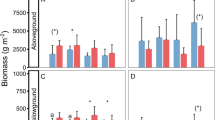Abstract
Earthworms make up the dominant fraction of the biomass of soil animals in most temperate grasslands and have important effects on the structure and function of these ecosystems. We hypothesized that the effects of elevated atmospheric CO2 on soil moisture and plant biomass production would increase earthworm activity, expressed as surface cast production. Using a screen-aided CO2 control facility (open top and open bottom rings), eight 1.2-m2 grassland plots in Switzerland have been maintained since March 1994 at ambient CO2 concentrations (350 μl CO2 l−1) and eight at elevated CO2 (610 μl CO2 l−1). Cumulative earthworm surface cast production measured 40 times over 1 year (April 1995–April 1996) in plots treated with elevated CO2 (2206 g dry mass m−2 year−1) was 35% greater (P<0.05) than that measured in plant communities maintained at ambient CO2 (1633 g dry mass m−2 year−1). At these rates of surface cast production, worms would require about 100 years to egest the equivalent of the amount of soil now found in the Ah horizon (top 15 cm) under current ambient CO2 concentrations, and 75 years under elevated CO2. Elevated atmospheric CO2 had no influence on the seasonality of earthworm activity. Cumulative surface cast production measured over the 7-week period immediately following the 6-week summer dry period in 1995 (no surface casting) was positively correlated (P<0.05) with the mean soil water content calculated over this dry and subsequent wetter period, when viewed across all treatments. However, no correlations were observed with soil temperature or with annual aboveground plant biomass productivity. No CO2-related differences were observed in total nitrogen (Ntot) and organic carbon (Corg) concentration of surface casts, although concentrations of both elements varied seasonally. The CO2-induced increase in earthworm surface casting activity corresponded to a 30% increase of the amount of Ntot (8.9 mg N m−2 vs. 6.9 mg N m−2) and Corg (126 mg C m−2 vs. 94 mg C m−2) egested by the worms in one year. Thus, our results demonstrate an important indirect stimulatory effect of elevated atmospheric CO2 on earthworm activity which may have profound effects on ecosystem function and plant community structure in the long term.
Similar content being viewed by others
Author information
Authors and Affiliations
Consortia
Additional information
Received: 3 November 1996 / Accepted: 11 January 1997
Rights and permissions
About this article
Cite this article
Johann G Zaller., Arnone III, J. & Zaller, J. Activity of surface-casting earthworms in a calcareous grassland under elevated atmospheric CO2 . Oecologia 111, 249–254 (1997). https://doi.org/10.1007/PL00008817
Issue Date:
DOI: https://doi.org/10.1007/PL00008817




